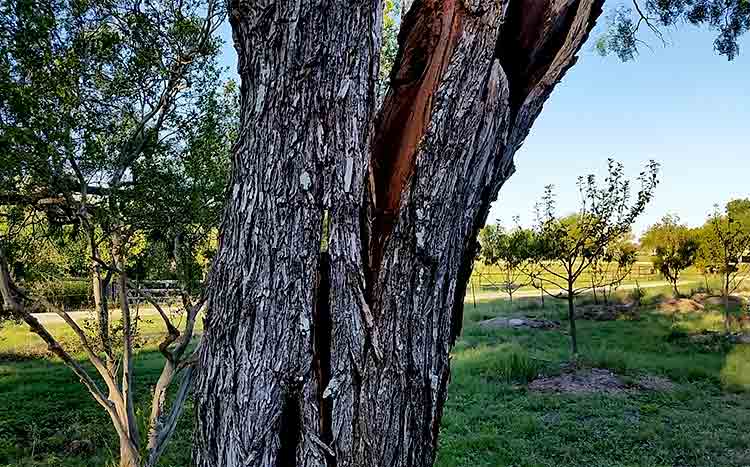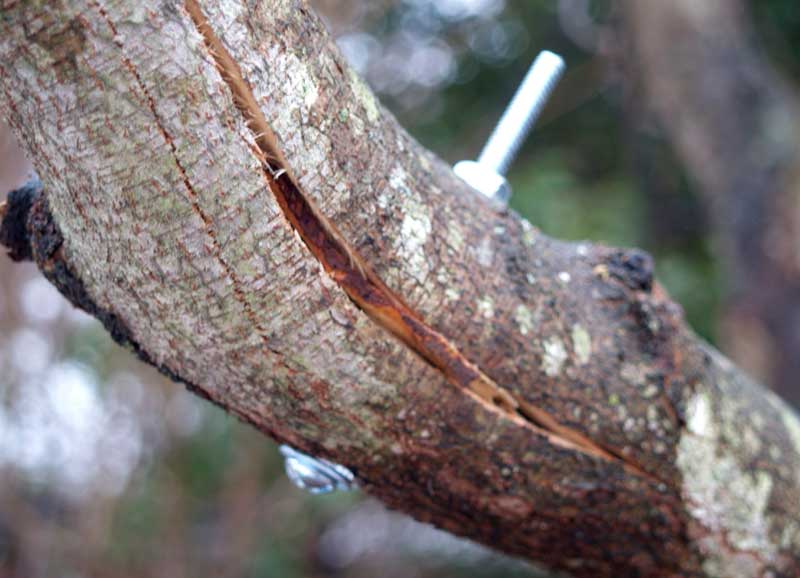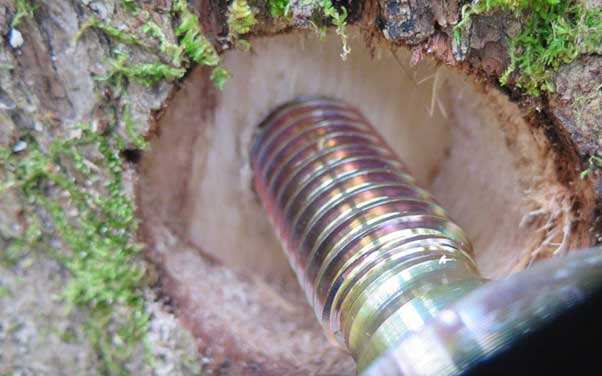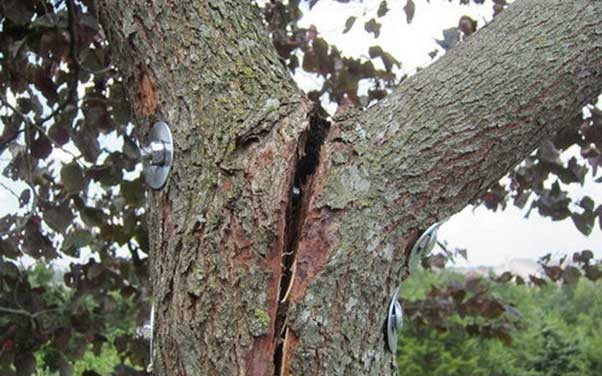Proper maintenance and care for trees are crucial to avoid the risk of them contracting diseases or experiencing cracks and splits. Several elements can lead to a tree splitting or its branches fracturing, among which harsh and fluctuating weather conditions are frequently identified as a primary cause. This raises the question: Is it possible to repair a tree trunk that has split?
If the tree trunk is not entirely split and fallen, it should be possible to repair it. You can do this by applying for structural support by bolting the tree. This is done by drilling holes through the trunk to install strong threaded stainless steel rods to support the trunk.
In some cases, the part of the trunk needed to feed a certain branch has been severed, therefore, the branches will eventually dry off, leading to the tree’s death.

What we cover
ToggleWhat causes a tree trunk to split vertically?
Although there are so many reasons why a tree trunk can split vertically, the most common one is a frost crack1. Alternating chilly and warm temperatures usually cause vertical splits. During cold winter days, the tree tends to contract while it expands on warm sunny days. If this continues for some time, it leads to vertical cracks in tree trunks.
Tree trunks can also crack if the tree is growing in hardiness zones. If the area tends to have unexpectedly low temperatures time and again, the trees may crack and get damaged.
Internal tree decay may also cause the tree to crack and split. If your tree is sick and you do not act fast, you will make the situation worse. A sick and split tree may not be able to recover, which may call for removal.
How to repair trunk damage
Just because a tree trunk has split or is damaged, it does not mean you have to remove the tree. Some trees may survive while others may not, depending on the extent of the crack and the tree’s general health. Below are some tips for repairing a damaged tree trunk.
Bolting
This is done by drilling 3 or more holes right through the split section of the trunk and then inserting bolts through it. Be sure to use large washers around each end of the bolt to create a larger surface area for better support.

Remove the tree’s wound completely
You can also repair damaged tree trunks by removing the wound completely. Start by removing the edges of the bark then cut the wound. This allows trees to heal better and faster. By so doing, you will enable the tree to transport the necessary nutrients and continue growing properly.
This task is not complicated, but if you doubt your skills, it is best to call a professional arborist to do it for you.
Reattach broken branches
Broken branches also cause damage to the tree trunk. If the branch is in good condition, you can reattach it to the tree. Duct tape comes in handy in such situations and can support the broken branch until it completely attaches to the tree. This way, you will save the branch from dying completely and help heal the tree’s trunk faster.
When reattaching the branch, make sure it is in the right direction because nutrients are transported in one direction only. So, if the reattachment is incorrect, the branch will die due to a lack of nutrients.
Should I remove the tree instead of repairing it?
In some cases, the tree’s trunk might be damaged to a point where it cannot be repaired and may become hazardous quite quickly.
If you are unsure about the state of the trunk and whether it may pose a danger, I suggest you get in contact with a local arborist near you. There are many ways to find a good local tree service at affordable prices, but the easiest way by far is to use THIS free service.
GoTreeQuotes helps to match you with the three local tree doctors who have been voted #1 by previous users in your area. They will give you free advice and estimates on any work that may need to be done.
- Scroll up to the top of the page and enter your ZIP Code in the blue form at the top of the page.
- Give us a few details about your tree job plus some contact information.
- Your tree details are forwarded on to the closest 3 tree cutting services, all voted best priced who will also price your tree job.
It is essential to hire a qualified arborist because the professional will know how to handle the tree better. More so, he/she will have all the necessary tools for the task and assure you of professional results.





How to bolt a tree trunk
If your large tree splits, you can use bolts and a rod to reconnect the trunk and save it. The bolts will support the tree until it heals. The following steps will guide you when bolting your tree.
Step 1- Make sure you place the bolt well to ensure it works perfectly. Drill a 6-inch hole below the crotch top, and be sure to attach large washers at the two ends of the bolt. The washers should be at least 3 inches in diameter and will allow you to tighten the nut and bolt without a hassle. Also, they will prevent you from digging too deep into the tree’s trunk.
Step 2 – Always keep an eye on the split or crack, and do not overtighten as you may damage the tree. Be keen to tighten close enough to bring the split halves together. If you hear cracking sounds, reduce the tightening.
Step 3 – Insert the rod to support the two halves fully. However, before you insert the rod, ensure you cut the cambium and bark away from the hole in a circular motion. This allows the washer to sit against the wood and allows new growth from the cut edges to cover the hardware faster.

How to repair split bark on a tree
When a tree bark splits, it is paramount to repair it as fast as possible. This is because the exposed inner tissue is more vulnerable and may lead to disease and harmful insect infestation. Below is a brief explanation of how to repair split bark caused by different conditions.

Sunscald treatment
Trees in the south and southwest are more prone to sunscald. Sunscald is caused by superheating followed by supercooling due to fluctuations in temperatures. This causes the inner bark to die and split.
If your tree is suffering from sunscald, let it heal on its own. Avoid filling the damaged bark with paint or sealer as it may interfere with the tree’s natural healing. Trim the wound lightly using a sharp knife to allow the tree to compartmentalize the damage faster. You can wrap the damaged area of the bark with a light-colored tree wrap to accelerate the healing.
You can prevent your tree from sunscald by planting it in areas shaded by large structures in late afternoons. You can also use white-colored tree wraps to reflect sunlight and prevent the tree from overheating. Planting evergreens will also help in shading the tree during hot weather.
Frost cracks
Fluctuations in temperature also lead to frost cracks. Frost cracks usually happen during late winter or early spring. The process to treat this condition is similar to treating sunscald. So, you should not use a wound sealer as it may interfere with the tree’s natural healing process.
Using a sharp knife, trim the wound lightly to make the healing process faster. You can then use a light-colored tree wrap to accelerate the tree’s healing.
To prevent frost cracks, prune your trees in late fall and winter. Also, fertilize in late fall and early spring.
Herbicides cracks
Some herbicides contain glyphosate products that may cause your tree’s bark to split. When you apply the herbicides directly to the tree either willingly or unwillingly, use the products too frequently near the tree, or apply high doses on the area surrounding the tree, the glyphosate deteriorates the inner bark of the tree.
So, as you are eliminating the winter hardness, you may be causing more damage to the tree. Treating cracks caused by herbicides is similar to frost cracks and sunscald bark splits.
However, you can prevent glyphosate damage by using herbicides with no adjuvant or wetting agents, using correct doses, maintaining a safe distance between your trees and the landscape you spray, or integrating other weed removal methods.
Can a tree survive a split tree trunk?
It is possible to save a split tree trunk if the split is not extensive. You can use nuts and bolts to join the split trunk to help it heal. If the tree’s damaged area is less than 25% of the trunk’s circumference, it can heal gradually and survive. However, if more than 50% of the tree’s crown is gone, it may not be possible to save the tree because it will lose its survival edge.
Can a broken tree trunk be repaired?
Yes, a broken tree trunk can be repaired. The best way to repair a broken tree trunk is by bracing or cabling it to provide much-needed support. If the attachment area is thicker, the tree can still share nutrients and heal. It is, however, critical to contact an arborist to get the best advice depending on the extent of the damage.
Will a split tree grow back together?
Yes, a split tree can grow back together if the damage is not extensive and if you act fast. Using nuts and bolts, you can reattach the split trunk to offer support and allow nutrients to pass through. This, however, needs patience because it may take months before the tree regains its shape.
- James Brown, (2023) What Causes Maple Tree Bark To Split? (SURPRISING FACTORS) <https://treepursuits.com/what-causes-maple-tree-bark-to-split/> Accessed: 15-02-2024




